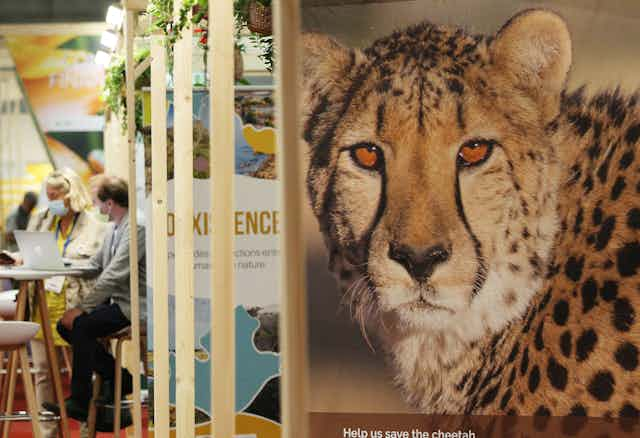Every four years, some of the biggest issues facing the planet are thrashed out in a global meeting of conservation scientists. The International Union for the Conservation of Nature (IUCN), the global authority on the status of the natural world, recently hosted the World Conservation Congress in Marseille, France, which was attended by 4,000 people, from government ministers and academics to indigenous leaders and business executives.
It was the first opportunity since the pandemic for researchers to present new findings on endangered species in the wild, share their ideas for protecting them and shape the course of conservation for the next half-decade.
Here are five of the most important outcomes.
Komodo dragons
The IUCN maintains the Red List of Threatened Species, which designates life forms as least concern, near threatened, vulnerable, endangered, critically endangered, extinct in the wild or extinct, based on their population size, range and the threats facing them. Species lacking the information necessary to make a judgement are categorised as data deficient. These rankings help focus conservation efforts where they are most urgently needed.
Komodo dragons were last assessed in 1996, when they were classified as vulnerable. In the recent congress, the world’s largest living lizard was downgraded to endangered, with scientists saying the species faced a very high risk of extinction in the wild due to climate change and habitat loss.
The latest assessment showed that there are only 1,383 mature dragons left on the few Indonesian islands where they are found. Rising temperatures and sea levels are predicted to reduce their habitat by a further 30% over the next 45 years.

Not all reptiles can be studied in as much detail as the Komodo dragon. Most are much smaller and more elusive, but possibly even more threatened by human activities, like competition with invasive species introduced by people. Hopefully, the Komodo dragon’s arrival on the endangered list will spur urgent action to safeguard it and other reptiles.
Sharks and rays
The number of shark and ray species facing extinction has doubled in less than ten years, with 41% of 611 ray species, and 36% of 536 shark species now at risk of dying out.
This grim news doesn’t just affect elasmobranchs (the family sharks and rays belong to). All species are part of intricate food webs, and a change in the numbers of one species can have drastic effects on others.
For example, the sea otter was nearly hunted to extinction in 19th-century North America as a result of the fur trade. The loss of so many of the critters cascaded across the ecosystem. The urchin populations that otters had kept in check through predation exploded. Masses of urchins overgrazed kelp forests, dooming thousands of inhabitants.
Something similar is underway with sharks. As bycatch and the shark fin trade has depleted Australian populations, smaller fish predators such as snappers have increased, reducing the number of algae-eating fish. In many areas, algae has engulfed coral reefs as a result, limiting their ability to grow and survive bleaching events.
Tuna
Tuna can grow to rival some of the largest fish in the ocean. Overfishing has depleted their populations, and larger tuna of breeding age are most likely to be caught as they fetch the highest prices. This leaves a diminished population of smaller fish which cannot replenish their numbers because they have yet to reach breeding age.
But there is, miraculously, some good news. Four of the seven commercially fished tuna species were upgraded to more favourable conservation statuses at the Congress, with the Atlantic bluefin tuna jumping three categories from endangered to least concern.
This is a tentative sign of population recovery, brought about by the enforcement of more sustainable fishing quotas which were set in 1998. Nevertheless, conservationists mustn’t get complacent. Although the Mediterranean population of Atlantic bluefin tuna has increased by 22% over the last 40 years, the population in the Gulf of Mexico has fallen by 50% over the same period.

Deep-sea mining
Deep-sea mining involves extracting metals and minerals, such as nickel and copper, typically for use in electronics. These elements have amassed over millions of years near hydrothermal vents in the depths of the ocean, and companies are proposing stripping away sections of the sea floor to get them.
There could be devastating consequences for the species down there, most of which scientists have only recently discovered. Compaction of the sea floor, sediment plumes and electromagnetic disruption are just some of the wider effects which could cause even more harm.
In order to protect this unique habitat, 85% of delegates voted in favour of a ban on deep-sea mining until a full impact assessment can be made. Although backed by government officials, the yes vote is only an expression of support. The IUCN has also been calling for climate action since 1960. A deep-sea mining moratorium would have to be instigated by the UN and International Seabed Authority to be effective.
Amazon
The IUCN also approved a call to action, proposed by indigenous groups, to prevent the collapse of the Amazon rainforest ecosystem. This motion, which was debated and approved by a congress vote, suggests that 80% of the Amazon should be protected by 2025 and largely managed by indigenous people.
Protected areas and indigenous territories currently account for only 45% of the Amazon. The resolution is fantastic news, not only for the rainforest and the vast biodiversity it contains, but for the people who live there.
This is the first IUCN Congress in which indigenous peoples have been included as full voting members in their own right, rather than considered as part of a larger category of nongovernmental organisations. It’s clear from the outcomes of the congress that while species are still declining at an alarming rate, there are a huge number of people devoted to reversing the destruction.

